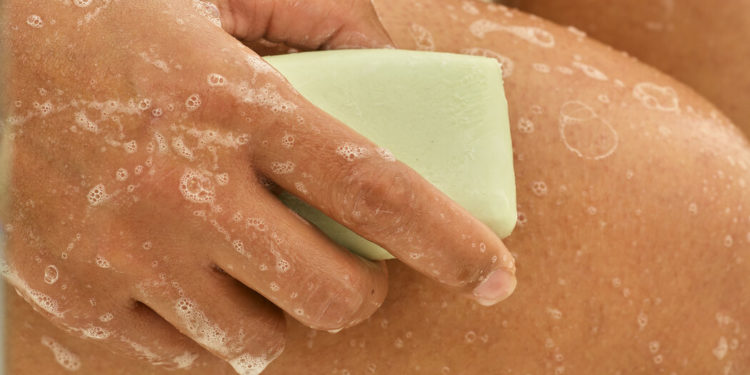Q: I’ve perfected a skin care routine for my face. Should I have something similar for the rest of my body?
Dermatologists see it all the time. Patients come in with flawless complexions, but below the neck it’s a different story.
Often, the skin on their bodies is so dry it “looks like alligator skin,” while their faces are well moisturized, said Dr. Ariel Ostad, a cosmetic dermatologist in New York City. Others have dry patches on their backs or dark spots on their hands and arms, said Dr. Lauren Ploch, a dermatologist in Aiken, S.C.
Many people neglect body care because the face is what’s usually on display, Dr. Ploch said. But the skin on the rest of your body needs just as much attention as that on your face. Here’s how to give it what it needs.
Less Is More
Your skin, the body’s largest organ, has many important functions. It regulates your body temperature and guards against issues like dehydration, damage from ultraviolet light and infection with potentially harmful microbes.
Any skin problem that can occur on your face — dryness, acne, sun damage, skin cancer — can crop up on the rest of your body, too, Dr. Ploch said.
In fact, for people with lighter skin tones, melanoma commonly starts on the chest and the back for men and on the legs for women, Dr. Ostad said.
When it comes to establishing a skin care routine for your body, less is more, said Dr. Lindsey Bordone, a dermatologist at NewYork-Presbyterian/Columbia hospital in New York City.
Dermatologists suggest this three-step routine.
Step 1: Cleanse properly
How often you shower is up to you. But scrubbing every inch of your body with soap every day could be overkill, especially if you’re prone to dry skin or eczema, Dr. Bordone said. Most soaps contain surfactants, which help to wash away dirt and oil but can degrade the skin’s protective barrier, resulting in dryness or irritation, Dr. Ostad said.
You generally need to lather up the entire body only two to three times a week, he said. “My patients do a double-take when I say this,” he added.
However, you do need to cleanse the areas that get dirty or sweaty, such as hands, feet, armpits, groin and buttocks, every day. And Dr. Ploch suggests washing your entire body with soap daily if your job requires frequent contact with people or germs, such as in health care or education.
You can use body wash or bar soap, but make sure it’s a gentle cleanser, Dr. Ploch said. Dr. Ostad recommended products with glycerin, niacinamide, urea, hyaluronic acid or ceramides, which are humectants, or substances that trap and replenish moisture in the skin.
Avoid antibacterial soaps, which can destroy healthy bacteria living on the skin and “set you up for an infection,” Dr. Bordone said. And stay away from rough body scrubs and items with fragrance, which might irritate the skin.
Step 2: Moisturize
Slathering lotion or cream all over your body, especially on your arms, legs, torso and hard-to-reach areas like your back, is essential for healthy skin, dermatologists say.
“Multiple times a day, patients come in and complain of itching on their back,” Dr. Ploch said. “We call this winter itch in dermatology.”
Moisturizing daily protects and repairs your skin’s barrier and keeps it hydrated, minimizing the likelihood of dryness and irritation, Dr. Ostad said.
You might need to moisturize more frequently during the winter months or if you’re prone to dry skin, Dr. Bordone said, or less frequently if you have oily or acne-prone skin.
Look for moisturizers with humectant ingredients similar to those in cleansers: ceramides, hyaluronic acid, urea, glycerin and shea butter, all of which lock in moisture, Dr. Ostad said. And use oil-free products if you have acne.
The best time to moisturize is just after stepping out of the shower and patting yourself dry, Dr. Bordone said. Apply a thick moisturizer to slightly damp skin to help it retain moisture throughout the day.
Step 3: Apply sunscreen
You should always apply sunscreen to any areas of your body that will be exposed to the sun, like your face, chest, arms, legs and hands, Dr. Ploch said. Often, older patients will have clear skin on their back and upper arms, she said, but “from their sleeve down, they’re mottled and spotted,” which is a sign of sun damage.
Most experts recommend using a sunscreen with SPF 30 or higher and reapplying it at least every two hours.
Daily sunscreen use protects your skin from harmful UV rays, lowers your risk for skin cancer and minimizes the signs of aging, like sunspots, pigmentation changes and wrinkles, Dr. Ploch said.
When to See a Dermatologist
See a specialist if your skin still feels tight, dry or irritated even after using a gentle cleanser and moisturizing daily, Dr. Ploch said. You could have a skin condition, such as acne, eczema or contact dermatitis, that needs treatment.
If you’re bothered by any wrinkles or sunspots, dermatologists may also recommend cosmetic procedures like Botox or laser treatments, she said.
The post Does My Body Need a Skin Care Routine? appeared first on New York Times.



















